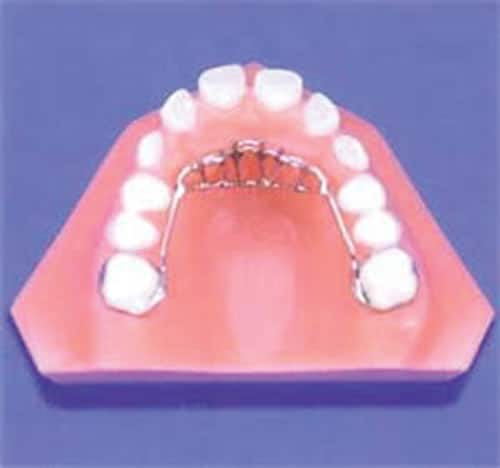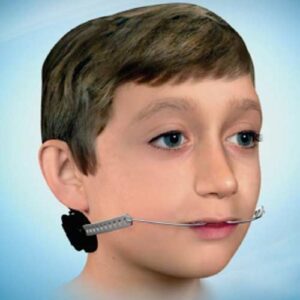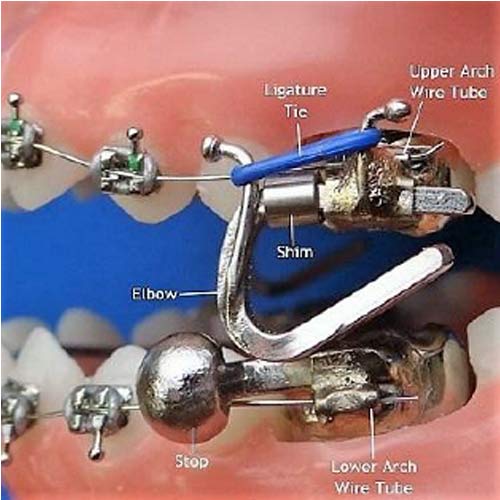Orthodontic Appliances
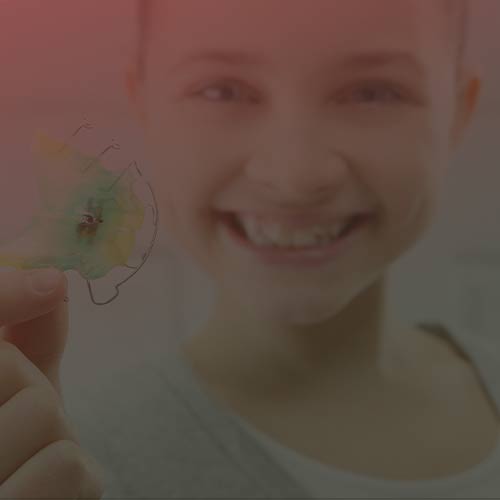
Orthodontic Appliances
Orthodontic appliances are not only limited to fixed and removable braces. In order to give you correctly aligned teeth as well as aligned and properly-functioning jaws, we use various appliances.
Here are some of the most common orthodontic appliances:
- Palatal Expander
- Headgear
- Reverse-Pull Headgear
- MARA
- Schwartz
- Crozat or ALF
- Habit Appliance
- Herbst Fixed Appliances
- Twin Block
- Bionator
Expanders
The jaw bone (mandible/maxilla) have growth sites and/on centers (sutures). In young kids, these areas can be painlessly encouraged to grow more effectively than the genes may be preprogrammed to direct. Once expansion occurs, the resulting wider jaw can allow more room for future permanent teeth to grow into. The expander is one of the most common orthodontic appliances for children and teens.
Upper Jaw Fixed Rapid Palatal Expander (RPE)
A palatal expander will be custom-made to fit over most of the top teeth in the back of the mouth. This appliance consists of two halves connected in the middle with a screw. You will be given a simple key which will be used to turn periodically and will generate a light and measured tension at the intersection of the two palatal bones (midline suture) which is the growth center of the maxilla.
This tension will progressively move the two bones apart. At the time of the desired expansion, the doctor will typically leave the expander in for a few (likely 6) more months to give the bones time to adapt and stabilize the new growth. This “active” part of the expansion will take on average about 1-3 months from start to finish. Occasionally the expander is swapped with another device, instead of being retained itself for these stabilizing months.

Lower Jaw Fixed Expander
The lower front teeth are often the area with the most crowding. The expander will be custom-made to fit behind most of the lower teeth. This appliance consists of two halves connected in the middle with a screw. Using a special key, you turn the screw a small measure periodically which will induce tension at the teeth and surrounding bone.
This pressure will progressively remodel the bone wider. This active part of the expansion will take on average about 3-6 months from start to finish. After the desired expansion is achieved, the doctor will leave the expander in for a few more months to give your bones time to adapt and stabilize the new growth. Often, the lower expander is swapped with another smaller device (holding wire) for the duration of the stability months (or years) needed.
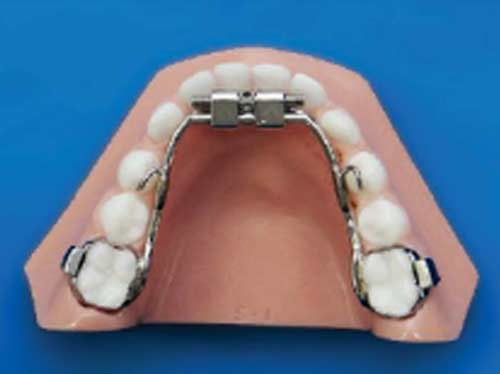
What is Headgear?…and why not something else?
We consider ALL options for the best orthodontic outcome. Orthodontic headgear is a very important part of the treatment for some patients. Headgear designs have changed notably over the years but no substitute really exists for them (despite what some may claim). A headgear appliance creates certain measured forces that guide the growth of the face and jaw bones from the outside of the mouth. Certain growth modification simply cannot be done with other alternatives. Another method is that it is also used to move teeth into better positions or to prevent teeth from moving.
Maintaining constant use of your headgear will achieve the best results. If instructions on usage are not followed, treatment will take longer and our treatment plan may have to change.
Proper timing (while a child’s jaw is young and interested in growing which typically is between 6-8 years) and compliance (wearing it every night) are critical to get the desired results.
High-Pull Headgear
High-Pull headgear applies gentle growing pressure, altering the unfavorable excessive down/forward growth of the upper jaw and teeth to a more balanced back/upward growth. This is sometimes called head cap head-gear. It pulls the upper jaw and teeth up and back.

Low-Pull Headgear
Low-Pull headgear applies gentle pressure to the upper jaw (maxilla). This way, the upper jaw and teeth excessive forward growth, is countered with the more ideal and balanced direction of growth. This allows the upper jaw to be held back.
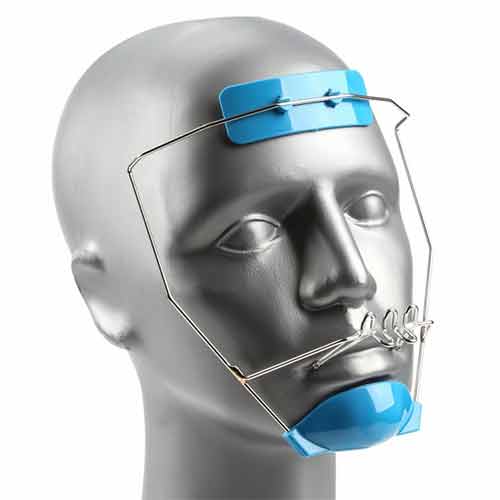
Reverse-Pull Headgear
Reverse-Pull headgear creates a measured force to help the upper jaw (and teeth) grow forward. This may be called a face mask. It rests against the chin and forehead and rubber bands are used to direct the light pressure for growth modification of the upper jaw and to move the teeth forward.
M.A.R.A.
(Mandibular Advancing Repositioning Appliance)
MARA (Mandibular Anterior Repositioning Appliance) is a “functional growth modification appliance”. Furthermore it helps alter the patient’s default jaw muscle and bone position into the ideal position, encouraging the jaw to “grow” into that position and balance. Basic MARA design employs separate upper and lower components which function together but don’t hinder full mouth opening. There is a horizontal “arm” in the lower arch that extends sideways from a extended orthodontic band (ring of metal) on the lower first molar. An “overlay” (temporary) stainless steel crown on the upper first molar has a vertical “elbow” that guides the lower jaw forward into the desired position. When adjusted, as the patient bites down, they will slide the lower jaw forward so that the lower arms slip in front of the elbows. This posture by the muscles directs the growth of the jaw bones.
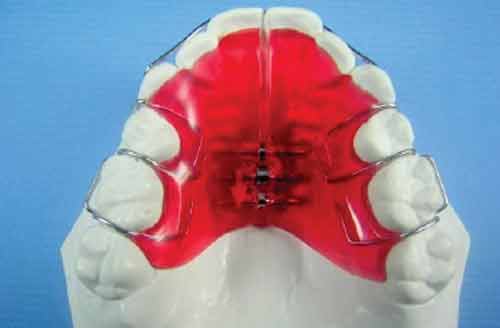
Schwartz
The Schwartz Appliance is a removable appliance designed to expand the upper or lower jaw (arch). This expansion creates appropriate arch width and more space for development of permanent teeth. It works by turning the expansion screw which generates a light and measured tension. Once the arch is expanded, the appliance can be left in place as a retainer, for a period of time, to stabilize and maintain the correction. The removable nature allows for easy maintenance (cleaning, brushing etc…). Requiring the patient to be responsible to wear and not lose the device.
Crozat or ALF
(Advanced Lightwire Functional Appliance)
When a young patient has excessive crowding and not enough room for their teeth, it’s often because there is genetic and environmental variables that prevent sufficient jaw growth naturally. The Crozat and ALF are custom designed removable orthodontic appliances to widen arches and improve the position of crowded teeth. They are made of wires that will clip onto certain teeth and exert pressure in the right place to make the mouth bigger. The removable nature allows for easy maintenance (cleaning, brushing etc…)
Although it requires the patient to be responsible to wear and not lose the device. Here are some precautions that would be good:
- “Sweep” wires are not connected on both sides, it’s important to not pull on these excessively with tongue or fingers.
- Place and remove the appliance with fingers only. Do not use your tongue or teeth.
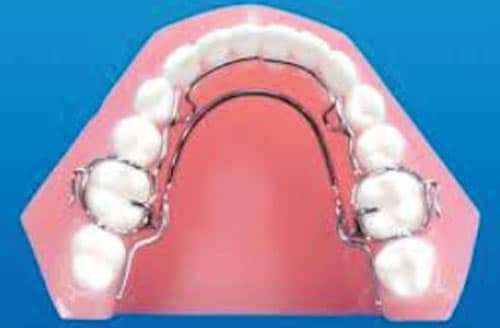
Habit Appliance Therapy
A tongue crib (like a fence) is used to alter the undesired habits of thumb/finger sucking or control a tongue thrusting habit. The tongue fence is a passive appliance designed to help reestablish the proper balance and equilibrium between the nature forces of muscle and lips from outside and the tongue from the inside on the growing jaw and teeth of a child. The bands are cemented onto a back molar on each side and the crib helps resist/break the powerful muscular force of the tongue or finger placed in the mouth. Spurs can be used as an additional habit breaker.
